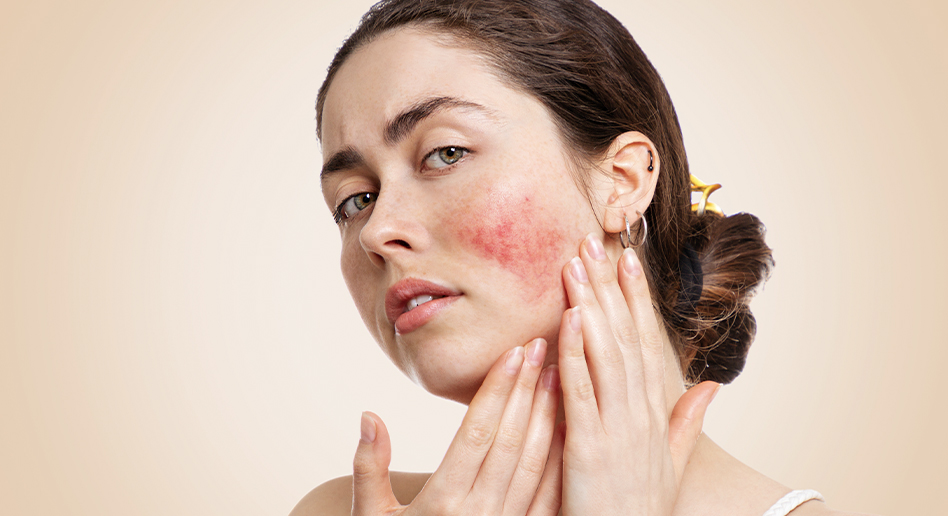17TH FEB 2025
Acne vs Rosacea

Skinsights > Acne vs Rosacea
Do I Have Acne or Rosacea? Symptoms and How to Tell?
- Skin issues can be confusing at the best of times. But when you’re facing persistent redness or breakouts, the question often arises – is it acne or rosacea? Both conditions can appear remarkably similar on the surface, but they’re driven by entirely different causes. Getting the right diagnosis is crucial for effective treatment. Here’s how to tell the difference – and what to do next.
Acne vs rosacea: what’s the difference?
- Acne and rosacea are like two squabbling siblings – similar in some ways but entirely different in temperament. Let’s break them down:
What is acne?
- Acne is a common skin condition caused by clogged pores, excess oil production, and bacteria. It’s often associated with hormonal changes but can persist well into adulthood.
Symptoms of acne include:
- - Whiteheads, blackheads, and pustules.
- - Red, inflamed bumps, sometimes painful to touch
- - Breakouts commonly appear on oily areas like the forehead, nose, chin, chest, and back.
- Acne tends to ebb and flow, with flare-ups often tied to stress, diet, or your monthly cycle.
What is rosacea?
- Rosacea, on the other hand, is a chronic inflammatory condition that primarily affects the face. While its exact cause isn’t fully understood, triggers such as heat, spicy foods, alcohol, and stress can worsen symptoms.
Symptoms of rosacea include:
- - Persistent redness, particularly on the cheeks, nose, chin, and forehead.
- - Visible blood vessels (a not-so-welcome roadmap across your face).
- - Small, red bumps that may look like acne but lack the tell-tale whitehead.
- - Flushing or sensitivity to skincare products.
- Unlike acne, rosacea doesn’t come and go; it’s a long-term companion that requires careful management.
Skin redness causes: is it acne or rosacea?
- So how do you tell whether your redness and bumps are acne or rosacea? Here’s the cheat sheet:
Location matters
- Acne tends to show up on oil-prone areas, while rosacea often centres on the middle of the face.
Spot the spots
- Acne has a mix of blackheads, whiteheads, and pustules. Rosacea’s bumps are red and lack the white centre.
Triggers
- Rosacea flare-ups are linked to external triggers like sun, heat, or certain foods. Acne, however, can pop up anytime, often influenced by internal factors like hormones.
Skin texture
- Rosacea often comes with a rough, dry texture, whereas acne-prone skin is typically oilier.
How to treat acne and rosacea
- The good news? Both conditions can be managed effectively with the right approach.
Acne treatment
- - Active ingredients such as salicylic acid or prescription tretinoin can work wonders.
- - Avoid overly harsh cleansers, which can strip your skin and make acne worse.
Skincare for rosacea
- - Opt for gentle, soothing skincare that calms redness and irritation.
- - Active ingredients such as metronidazole and azelaic acid are game-changers for your skin.
- - Avoid common irritants such as alcohol-based products and exfoliants.
When to call in the experts
- If you’re still unsure whether it’s acne or rosacea – or your current routine isn’t cutting it – it’s time to consult the pros. At ilik, we specialise in tailored skincare solutions designed to address specific concerns like acne treatment, rosacea symptoms, and beyond. Our science-backed approach means you’ll get a personalised plan that works for your skin, without any guesswork.
The bottom line
- Whether you’re battling stubborn spots or a flare of redness, understanding your skin is the first step to taking control. Acne and rosacea may look similar, but they demand entirely different treatments. Our skin experts are on hand to help you choose wisely, give you the right advice, so that clear, healthy skin is within reach.

